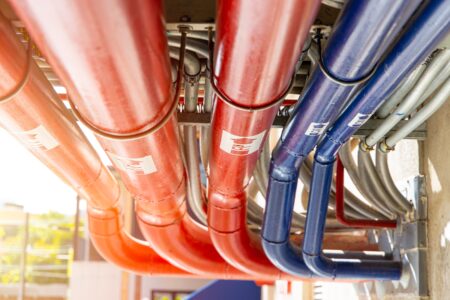 In the intricate network of pipes and fixtures that make up a building’s plumbing system, there is often one overlooked component that plays a crucial role in maintaining its efficiency and performance; the plumbing stack. This vertical conduit is essential in maintaining the balance and functionality of our plumbing infrastructure and serves as the unsung hero of our drainage systems, ensuring everything flows smoothly and odorlessly. The two primary purposes it has in your plumbing system are:
In the intricate network of pipes and fixtures that make up a building’s plumbing system, there is often one overlooked component that plays a crucial role in maintaining its efficiency and performance; the plumbing stack. This vertical conduit is essential in maintaining the balance and functionality of our plumbing infrastructure and serves as the unsung hero of our drainage systems, ensuring everything flows smoothly and odorlessly. The two primary purposes it has in your plumbing system are:
- removes the sewage from your home
- releases noxious sewer gases outside
Below, we’ll dive into the world of plumbing vent stacks, unraveling what they are, their functions, types, and why they are vital to the health of any plumbing setup. Whether you’re a curious homeowner or need expert plumbing services, let this blog serve as your compass.
Decoding Plumbing Stacks – The Backbone of a Healthy Plumbing System
A plumbing stack is a vertical pipe that supports all other pipes in your home, allowing water to flow with ease as well as preventing dangerous and unpleasant gases from getting inside. It extends from the drainage system to the open air above the roof. Also known as a plumbing vent stack or soil stack, a plumbing stack plays a crucial part in a building’s plumbing system, ensuring proper functionality and sanitation with its ventilation and drainage components throughout the building. After waste enters a toilet, sink, or shower, it exits through a dipped section of pipe underneath, called the trap. A trap prevents sewer gases from leaking into your home or business. The trap connects to the waste or sanitary line, which takes it to a vent stack. At your building’s lowest point, the sewer stack is attached and rises to and out of the roof. This is how waste is removed from your home and taken to the sewer main.
The Anatomy of Plumbing Stacks
The core of the plumbing stack is a vertical pipe that runs from the lowest point of the drainage system (usually the basement or lowest floor) to the highest point, which typically extends above the roof. This vertical orientation allows for proper airflow and ventilation.
A vent cap, sometimes referred to as a vent stack cap or vent stack cover, serves a crucial role in preventing debris, pests, and weather elements from entering the plumbing stack while still allowing air to flow freely.
The lower end of the plumbing stack is connected to the building’s drainage system, which includes all the pipes that collect and transport wastewater from sinks, toilets, showers, and other fixtures. This connection allows the plumbing stack to serve as a vent for the entire drainage system.
The plumbing stack extends through the roof of the building, ensuring it reaches the open air above. This penetration is typically sealed around the edges to prevent water leakage and is designed to withstand weather elements.
Types of Plumbing Stacks
There are two main types of plumbing stacks, and the one in your home is likely dependent on when your home was built.
Cast Iron Pipes
Cast iron pipes are more common in homes built in the 1970s or earlier. Cast iron is a heavy-duty and durable material that can handle the constant rush of water that plumbing systems produce. Despite their durability, however, cast iron pipes are prone to corrosion over time and are very heavy.
Cast iron pipes can corrode from the inside out. Corrosion results in rust, which can then flake off and create clogs in the pipes, which are difficult to detect until there is a sewer issue like clogged drains or a sewer backup.
PVC Pipes
PVC is a common material for plumbing stacks because it is lightweight and won’t rust. This type of plumbing stack is more commonly found in homes built after 1980. Homes built between 1970 and 1980 may have PVC or cast iron pipes, as both were used during this time.
PVC pipes can be louder than cast iron because they don’t dampen sound as well. However, because the material is smoother than cast iron, water can flow more easily, resulting in less chance of a blocked drain.
Why Partner With Fosh Plumbing & Heating Inc.?
Whether you are looking to do a soil stack replacement, are interested in cracked sewer pipe repairs, or need to fix broken cast iron pipes, contact the experts at Fosh today for all your plumbing service needs.





